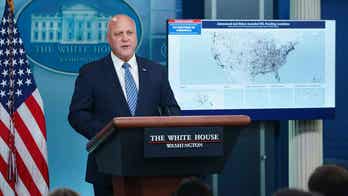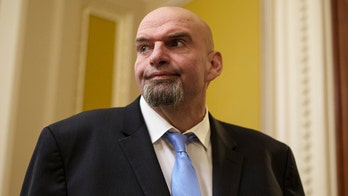
Oct. 30, 2014: A TSA officer, left, checks a passenger's ticket, boarding pass and passport as part of security screening at John F. Kennedy International Airport in New York. (AP)
WASHINGTON – A court challenge over the difficult process for airline passengers to remove their names from the U.S. government's list of suspected terrorists banned from flying is taking an unexpected twist, now focusing on the mysterious ways federal agents add passenger names to the no-fly list in the first place.
The latest filing in a five-year federal case challenges the government's undisclosed method of predicting who might commit a terrorist act in the future. The case could provide a glimpse into the government's secret practices based on details about an airline passenger's friendships, travels, financial transactions and more.
Plaintiffs in the case, represented by the American Civil Liberties Union, want the government to provide all the reasons, including evidence, why they are on the no-fly list, a roster of tens of thousands of people banned from flying to, from, within or over the U.S. They want to challenge those reasons in a court hearing.
As a result of the lawsuit filed in Portland, Oregon, the Obama administration came up with a new policy earlier this year to tell some Americans whether and why they were on the list. These changes partially lifted a veil of secrecy enshrouding a policy that has been a centerpiece of the government's counterterrorism efforts since the September 2001 terror attacks. But the government's vague justifications and lack of details about its predictive formula are reminders of just how much opacity exists in U.S. counterterrorism policies.
And for good reason, the government has said: Disclosing details and evidence about why the U.S. thinks someone is likely to carry out a terrorist act would compromise ongoing investigations, jeopardize national security and defeat the purpose of the no-fly list.
Placement on the list, the government said in a May court filing, "requires predictive assessments about conduct that may or may not occur in the future."
Risk assessments predicting future behavior are becoming more common in criminal justice systems across the country. But the ACLU said those risk assessments used in the states and even some federal systems are based on scientific models, and most people undergoing the assessment have been at least charged with a violent crime. Some people on the no-fly list have neither been charged with a terror-related crime nor any crime. Some may not even be the subject of a current FBI investigation.
Risk-assessment experts supporting the plaintiffs said in court filings that even if the government has a formula, terrorist incidents are so few, an assessment tool used to predict who will engage in terrorism is unlikely to be very accurate.
The Justice Department declined to comment beyond the government's previous court filings.
The government has said that there are specific criteria for being placed on the no-fly list: A person must pose a threat of carrying out an act of international or domestic terrorism involving an aircraft, or a terrorist act "with respect to the homeland," or a terror act against a U.S. facility or personnel overseas, or pose a threat of carrying out a terror act and is also "operationally capable" of doing so.
And while those criteria are more specific than what the government had disclosed publicly in previous years, they don't go far enough to explain why an American is on the no-fly list, the ACLU said.
"What on earth does it mean to be a threat of something?" asked ACLU attorney Hina Shamsi. Not having these details leaves the process open to discriminatory and arbitrary decision-making, she said. She called the government's standard "we know it when we see it."




